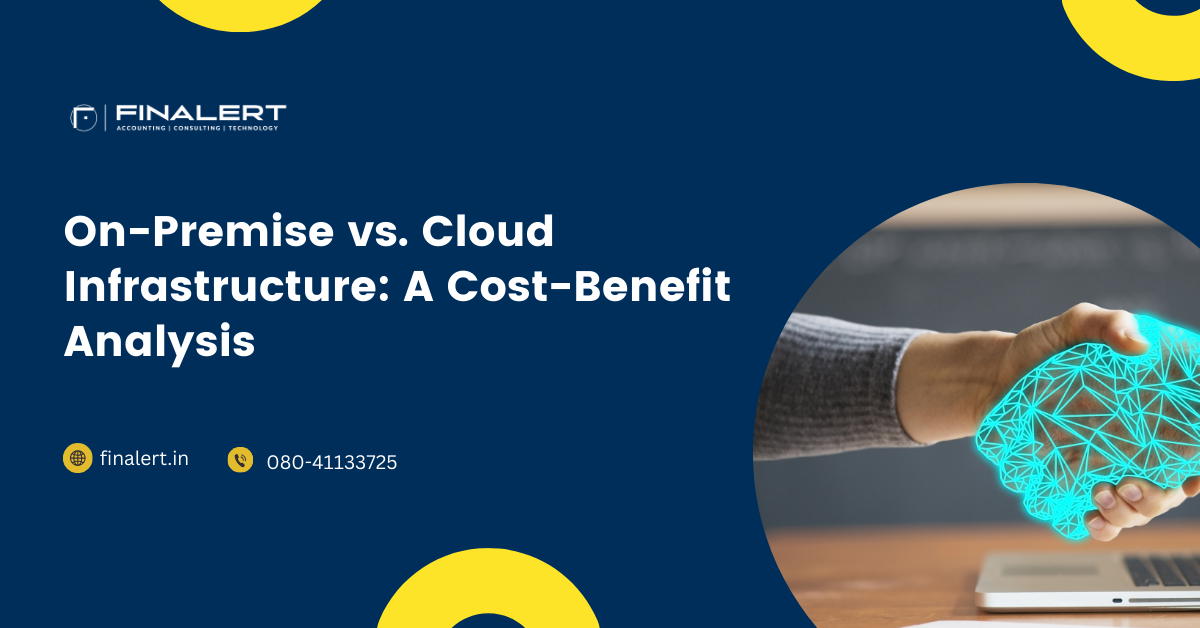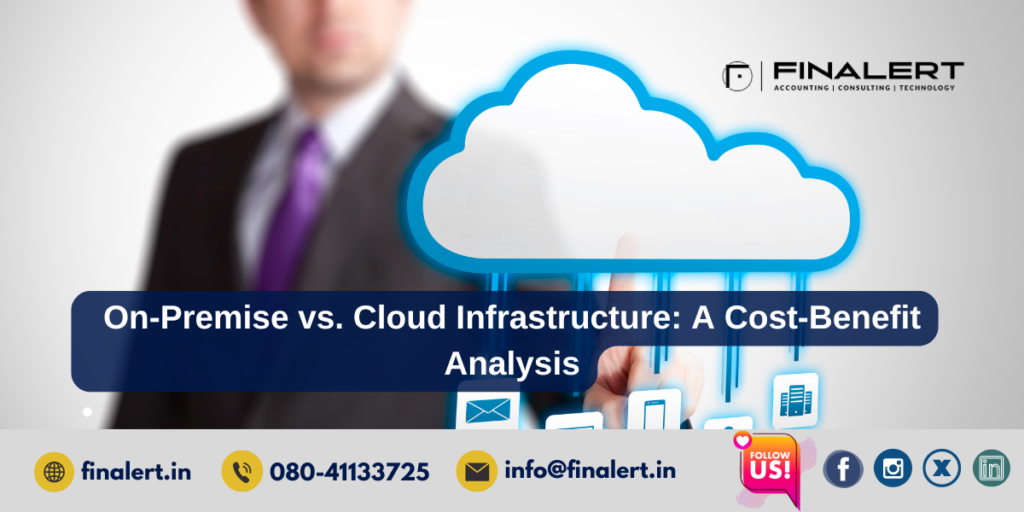As businesses across finance, accounting, and consulting navigate an increasingly digital world, choosing the right infrastructure is crucial. In 2024, the debate between on-premise and cloud-based infrastructure continues to dominate strategic discussions. Each model comes with its distinct advantages, costs, and challenges, leaving business leaders to weigh multiple factors like security, scalability, cost-efficiency, and regulatory compliance.
This cost-benefit analysis will dive deep into the merits and drawbacks of both on-premise and cloud infrastructure models, providing actionable insights for businesses seeking optimal solutions in today’s competitive market.

Understanding On-Premise Infrastructure
On-premise infrastructure refers to physical servers, networking equipment, and IT resources hosted and managed within a company’s facility. Traditionally, this approach has been the go-to choice for large enterprises seeking total control over their IT environments.
Key Benefits of On-Premise Infrastructure
- Full Control Over Hardware and Data: Businesses retain total control over their data and hardware, making on-premise systems highly customizable and secure.
- Enhanced Security and Privacy: In industries such as finance and accounting, data security is paramount. On-premise infrastructure allows for direct oversight of sensitive financial data, reducing the risks of third-party breaches.
- Long-Term Stability: Once the infrastructure is set up, businesses face predictable operational costs, including maintenance and staffing. There are no surprise fees associated with scaling, making on-premise solutions attractive for businesses with stable or predictable IT demands.
Challenges of On-Premise Infrastructure
- High Upfront Costs: Implementing on-premise systems involves significant capital investments in hardware, networking, and data center facilities. Businesses also need to budget for software licenses and specialized IT staff.
- Ongoing Maintenance and Staffing: In-house IT teams are required to handle day-to-day maintenance, security updates, and hardware upgrades. This leads to higher operational costs and long-term staffing commitments.
- Limited Scalability: As business needs grow, expanding an on-premise infrastructure requires purchasing additional hardware and space, leading to potential downtime and delays.
Case Study: Financial Institution Opts for On-Premise
A major financial institution with strict regulatory requirements opted for on-premise infrastructure to maintain direct control over sensitive customer data. Despite the higher upfront costs, the firm saw this as an essential investment to ensure compliance with data privacy laws and mitigate the risks of cloud-based vulnerabilities.
Exploring Cloud Infrastructure
Cloud infrastructure refers to IT services provided over the internet by third-party vendors. Cloud computing has gained significant traction due to its flexibility, scalability, and cost-efficiency, making it a popular choice for businesses of all sizes.
Advantages of Cloud Infrastructure
- Cost Efficiency: Cloud providers use a pay-as-you-go model, meaning businesses only pay for the resources they use. This can lead to significant cost savings, especially for startups and small businesses that cannot afford large capital expenditures.
- Seamless Scalability: Cloud infrastructure offers unparalleled scalability, allowing businesses to expand their IT resources instantly to accommodate growth or seasonal demand spikes. This is especially valuable for companies with unpredictable workloads.
- Automatic Updates and Maintenance: Cloud vendors handle system updates, patches, and maintenance, reducing the burden on internal IT teams and minimizing downtime.
Challenges of Cloud Infrastructure
- Data Security Concerns: Despite the high security standards implemented by cloud providers, businesses in highly regulated industries may be wary of storing sensitive data on third-party servers.
- Ongoing Subscription Costs: While upfront costs are lower, businesses must consider long-term subscription fees for cloud services, which can accumulate over time, especially for larger enterprises with heavy usage.
- Limited Customization: Cloud infrastructure is generally standardized, limiting a business’s ability to customize its IT environment to unique operational needs.
Case Study: Cloud Adoption in Consulting
A global consulting firm adopted cloud infrastructure to streamline project collaboration across offices worldwide. The firm valued the cloud’s scalability and flexibility, which allowed it to quickly adapt to changing client demands and improve internal efficiency. While the firm initially had concerns about data security, partnering with a cloud provider that offered industry-specific compliance mitigated those risks.
Cost-Benefit Breakdown: On-Premise vs. Cloud
To make a well-informed decision, businesses must evaluate the financial and operational implications of both infrastructure models. This section provides a comparative analysis of key cost and benefit factors.
Upfront vs. Ongoing Costs
- On-Premise: The initial capital outlay for on-premise infrastructure is substantial, covering the cost of servers, storage, networking equipment, and software. Once implemented, ongoing costs are generally limited to maintenance, power, cooling, and staffing.
- Cloud: Cloud infrastructure requires minimal upfront investment but comes with ongoing subscription fees based on usage. These fees can scale with demand, leading to long-term cost variability. However, businesses avoid the hefty initial capital expenditure.
Scalability
- On-Premise: Scaling on-premise infrastructure is resource-intensive, often requiring new hardware purchases and potential downtime during implementation. This lack of flexibility can hinder fast-growing businesses.
- Cloud: Cloud services offer nearly infinite scalability. Businesses can quickly scale up or down based on current needs, allowing for rapid responses to market changes or seasonal variations in demand.
Security and Compliance
- On-Premise: On-premise infrastructure offers greater control over data security, which is essential for highly regulated industries. Businesses can implement and manage custom security protocols to meet specific compliance standards.
- Cloud: Although cloud providers offer advanced security features, businesses may still be concerned about third-party access to sensitive data. However, most top-tier cloud providers now comply with industry-specific standards like GDPR and HIPAA, making cloud solutions more viable for regulated industries.
Actionable Insight: When making an infrastructure decision, businesses should perform a Total Cost of Ownership (TCO) analysis to understand the long-term financial implications of both models, accounting for factors like scalability, maintenance, and compliance needs.
Hybrid Infrastructure: A Compromise for Modern Businesses
For businesses torn between on-premise and cloud solutions, hybrid infrastructure offers a middle ground. In a hybrid model, businesses maintain critical systems and sensitive data on-premise while leveraging cloud infrastructure for less sensitive operations or overflow capacity.
Key Benefits of Hybrid Infrastructure
- Enhanced Security and Compliance: Businesses can store sensitive data in-house to meet regulatory requirements while utilizing cloud services for non-sensitive tasks.
- Optimized Costs: A hybrid model allows businesses to use the cloud for temporary scalability needs, avoiding the high costs of purchasing additional hardware for short-term spikes in demand.
- Flexibility and Resilience: The hybrid approach offers flexibility, allowing businesses to dynamically allocate workloads between on-premise and cloud environments based on real-time needs.
Challenges of Hybrid Infrastructure
- Complexity: Managing both on-premise and cloud systems requires advanced IT expertise and seamless integration. The complexity of hybrid infrastructure can be a significant challenge for smaller businesses.
- Coordination and Data Flow: Ensuring smooth communication between on-premise and cloud systems is essential to prevent data silos and maintain operational efficiency.
Practical Example: A global financial services firm adopted a hybrid infrastructure, keeping sensitive customer data on-premise to meet compliance requirements, while using cloud services for front-office applications like customer relationship management (CRM) systems. This balance allowed the firm to meet security standards without sacrificing agility.
Specific Industry Considerations: Finance, Accounting, and Consulting
Different industries face unique challenges when it comes to choosing between on-premise and cloud infrastructure. This section explores how businesses in finance, accounting, and consulting can approach their infrastructure decisions.
Finance and Accounting
- Regulatory Compliance: Financial institutions face stringent regulations regarding data privacy and security, such as GDPR and SOX. For many, on-premise infrastructure provides the control necessary to meet these standards, though cloud providers are increasingly offering compliance-certified solutions.
- Cost Management: Financial firms can benefit from cloud infrastructure’s cost savings, particularly for handling fluctuating transaction volumes. Cloud solutions also allow for rapid disaster recovery and backup systems.
Consulting
- Collaboration and Project Management: Consulting firms often work on multiple, complex projects that require seamless collaboration between teams. Cloud infrastructure’s scalability and accessibility make it ideal for managing remote teams and dynamic client needs.
- Data Privacy: Consulting firms handling sensitive client data may prefer on-premise solutions for projects involving confidential information, while using the cloud for less sensitive functions.
Actionable Advice: Consulting firms should consider hybrid models to secure client data on-premise while leveraging cloud infrastructure for collaborative tools and project management applications.
Conclusion: Finding the Right Fit for Your Business
Choosing between on-premise and cloud infrastructure is not a one-size-fits-all decision. Businesses need to evaluate their specific needs, considering factors like scalability, security, compliance, and long-term cost implications. While on-premise infrastructure offers control and customization, cloud solutions provide flexibility, scalability, and cost-efficiency.
For businesses seeking a tailored approach, a hybrid model may offer the best of both worlds, ensuring data security while enabling growth and flexibility. As 2024 approaches, now is the time to assess your IT infrastructure needs and determine which model aligns with your long-term business goals.
Final Thought: Whether you’re in finance, accounting, or consulting, understanding your infrastructure options is crucial for staying competitive in an increasingly digital world.

